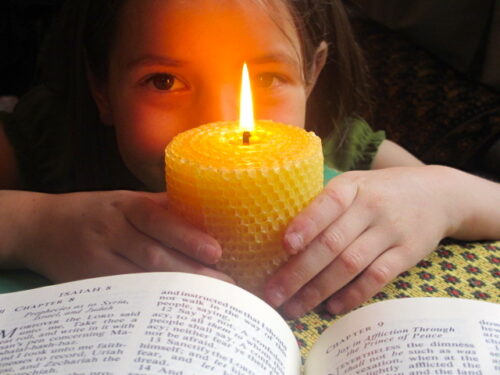 Each Shine session has a spiritual practice to share with your group during Connect to God (Sing and Pray in PreK–Kindergarten). These spiritual practices may include music, movement, writing prompts, moments of silence, or an object to help children focus. Student resources reinforce these practices, inviting children and youth to make them a part of their daily lives. Here are 10 tips to help you guide your group in the spiritual practice each week.
Each Shine session has a spiritual practice to share with your group during Connect to God (Sing and Pray in PreK–Kindergarten). These spiritual practices may include music, movement, writing prompts, moments of silence, or an object to help children focus. Student resources reinforce these practices, inviting children and youth to make them a part of their daily lives. Here are 10 tips to help you guide your group in the spiritual practice each week.
- Invite and inspire. We can’t force anyone to pray, but we can invite them to participate. Focus on creating a welcoming, inspiring, and comfortable atmosphere for children and youth to connect with God. Be clear in sharing your expectation that everyone needs to be respectful while the group is praying.
- Incorporate movement. Children sit a lot, so it’s important to include movement throughout a session, particularly as they learn to engage with God since that is often less familiar. Using different postures, such as kneeling, standing, sitting, and dancing, for prayer and celebration can help connect the mind, body, and heart in talking with God.
- Be a model. As they get older, children are often more self-conscious about moving their bodies or trying new things in front of others. However, if you throw yourself into activities with genuine enthusiasm, they will likely join you. Encourage children and youth to come up with their own worshipful body positions or have everyone close their eyes so they can move and know they are not being watched. They may also find it challenging to generate ideas for prayer. Begin a time of open prayer by sharing your own prayer aloud. For example, “God, I’m thinking about my friend who has been sick for a while. I pray that you will bring her healing and laughter.” Hearing your ideas may spark ideas for them and guide them in the way of prayer.
- Encourage participation and leadership. Provide opportunities for children and youth to lead in prayer, singing, playing musical instruments, candle lighting, and other ways. Children want to know they have a place and that their participation and leadership are valued and desired.
- Provide a focal image. Connecting with God is sacred and holy. Make the time memorable by spreading out a cloth, lighting a candle, or using other objects to focus the eye and the heart. Placing a small candle in a large glass jar makes the light easy to see and safely move the candle if necessary. Using a battery-operated candle is a great option for groups where a regular candle is problematic.
- Practice. It takes time to learn new ways of connecting with God. In the week leading up to each session, pray in the manner suggested so that it becomes familiar. Your preparation will be a gift for you and your group.
- Slow down. Becoming still before God or making space to encounter God takes time. If a prayer includes a pause to imagine or respond, try not to rush. Begin with a short amount of silence, then gradually increase the time spent in silence by 10 seconds until it becomes comfortable for the children. Holding space amid prayer reminds them that connecting with God is important and something to be valued rather than rushed through to get to other things.
- Provide support. Children’s ability to engage in quiet or still activities differ. Before prayer time, encourage children to find a space where they won’t distract each other. Suggest that they lay their hands in their lap or give them something to hold. Prayerful silence directs a child’s attention and activity inward; asking them to be quiet can leave them at loose ends. Before you begin, let children know that if their attention wanders, they can simply direct it back to their breathing. Don’t be concerned or upset if children move around or make noise; this is normal. Gently direct children’s attention back to prayer or worship.
- Signal. When calling children to prayer, or if you want to signal them during prayer, try using a set of chimes, a triangle, or a hand-held drum. Short, soft, musical signals will catch the children’s attention without shifting them out of a prayerful space.
- Adapt. The session plan’s prayers, practices, and rituals are suggestions. It is important to adapt them for your group as needed. If a prayer practice is especially liked by your group, feel free to use it multiple times during the quarter.
Visit the Shine Pinterest page at www.pinterest.com/shinelivingingo and go to the Spiritual Practices board to find journaling prompts, table graces, prayer stations, books, and more tips for using spiritual practices with your group.
Facebook
Email


